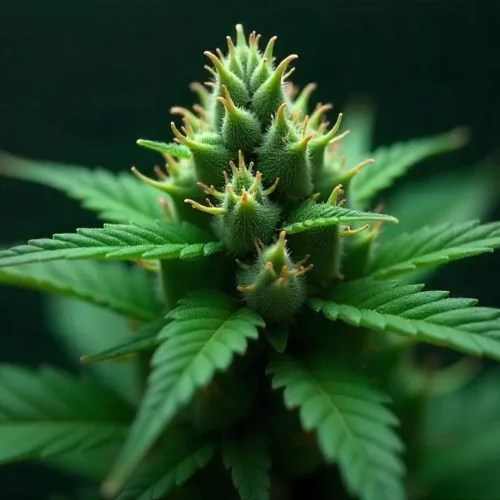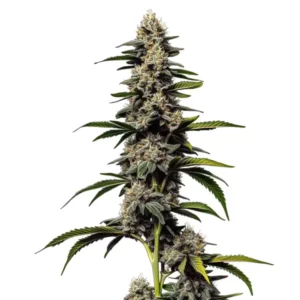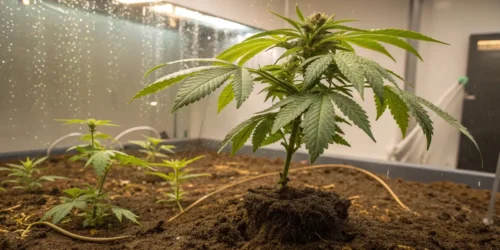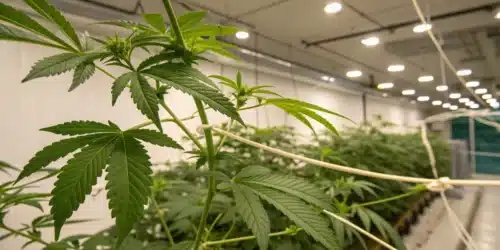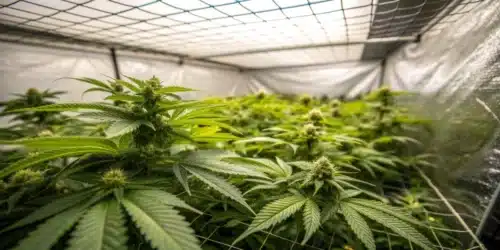Many people who try to grow marijuana suffer from the death of their plants or from the problems that they present. One of the most common is nutrient deficiency, a problem that is caused by the lack of macro or micronutrients caused by inadequate pH or simply due to insufficient nutrition. This can occur because the substrate or soil where it is grown is poor in nutrients or because the appropriate fertilizers are not used or simply, the plant is not nourished.
So, if we want to have a good crop with strong and robust plants, it is necessary to know that cannabis plants, like people, have different life processes. For the same reason, it is necessary to follow a scheduled feeding plan throughout the crop in addition to taking care of certain technical issues to ensure good plants and avoid problems due to food deficiency.
Recommended Strains
Macronutrient deficiency
The three primary nutrients are nitrogen (N), phosphorus (P), and potassium (K) which are considered macronutrients and are needed for the growth of cannabis plants. They also need other types of secondary nutrients and micronutrients which help in growth and flowering. The nutritional deficiencies of weed plants come from underfeeding, pH imbalance, and nutrient lockout. For this reason, when a deficiency is not treated, it can cause different problems, including the death of cannabis plants.
Nitrogen
Nitrogen deficiency is probably the most frequently reported deficiency by cannabis growers. It is usually easy to identify and can be corrected as soon as it becomes apparent. Although, in the early stages, it shares a basic resemblance to other deficiencies. In the early stages of nitrogen deficiency, leaves appear too light in color, almost yellowish green, compared to the desired deep green of healthy leaves. Also, leaves that are nitrogen deficient tend to have slightly darker veins compared to the very light color of the leaf tissue itself, although the contrast is not as marked as in other deficiencies.
In contrast, the leaves with excess nitrogen appear dark green, almost black in the most extreme cases and this phenomenon is also a problem for the plant because it prevents its optimal development. In severe cases of nitrogen deficiency, the leaves appear to become increasingly lighter in color and eventually begin to dry out and die. Usually, the large leaves on the lower and outer part of the plant are the first to be affected and the first to die.
Phosphorus
Phosphorus is very important for plants, both in their growth and also for the development of their roots, leaves, stems, and branches. Therefore, a plant lacking in phosphorus tends to be weak and have poor growth with small and weak leaves. As plants with this deficiency grow, they show a dark color that demonstrates their deficiency.
The leaves when grown are shown with violaceous colors, which then turn to brown and curve downwards. Also, the small stem that joins the leaf to the main stem shows a purple hue. At the end of growth, the leaves of the plant take on a yellowish green color. On the other hand, the lack of phosphorus usually affects the outer and lower leaves first. This type of deficiency is essential for the entire cycle of the plant, especially when it is small and when it is in bloom.
Potassium
Potassium deficiency in cannabis plants is very common when grown in soil or substrate. It occurs when there is a lot of calcium or nitrogen in the substrate and it becomes difficult to correct them. Therefore, it is good to correct the potassium and calcium levels to fix the problems with potassium. Analyzing the PH and washing the roots are the ways in which a mismatch with potassium can be corrected.
When there are problems with potassium, the leaves turn light yellow at the tips and then turn brown, curling up or down. The appearance of the leaves changes to burnt or dry as potassium deficiency progresses and spots also appear on the upper part of the leaves, generating a deformation in the new leaves and causing the old leaves to drop.
Promos & Deals
Control the PH
It is important to have a controlled and measured PH in the solutions with which the plant is watered because if the PH is higher or lower, your plants will not be able to absorb the minerals even if they are in the substrate or in the mixture of nutrients. The above occurs because cannabis plants can only absorb nutrients if the nutrients have the perfect PH, that is, a very alkaline PH is more than 7 and when the PH is less than 7 is acid, meaning that some nutrients cannot be taken up by the roots which can lead to nutrient lockout and unwanted nutritional deficiency.
Keep in mind that in a culture in substrate or soil, the perfect PH is 6-7 and if the cannabis plants are grown in a hydroponic system, it should be 5.5-6.5. You should know that although sometimes the PH measurements in hydroponics were correct, the plants can be affected by the deficiency of other nutrients which produces a blockage in the weed plants. Apart from measuring the PH in the liquid nutrients that are given to the plant, it is important to know the amount of total dissolved salts which is commonly known as EC measurement.
Bad EC control
Measuring the electroconductivity of the medium in which it is grown when the nutrients have been mixed is a matter of vital importance because the plants feed through an electric conductivity system. For this reason, if the EC is not at the correct point, a blockage is generated in the plant which prevents it from feeding correctly, especially if it is grown in hydroponic or coconut fiber system. To carry out this measurement, you should use an EC meter which you can buy at any grow shop and it will help you to have a perfect EC for your weed plants.
A perfect EC for growing marijuana is 0.5 to 0.8 when the seedlings are 15 days from germination. Then, we will raise the levels to 1.1 until the end of the growth phase. When flowering begins, we must raise the levels because the plant will close a greater amount of nutrients. You have to set the EC between 1.2 and 1.5 and keep it until you reach the fattening phase where we will raise it to 1.8/2.1. This will be our maximum level.
Now, to raise EC levels, you simply have to add more fertilizer to the mix or change the nutrient solution for one with a higher nutritional load. Novice growers often make the mistake of only measuring the water. The EC values that count are those in the soil which is where our plants eat. A trick to correctly measure the EC when grown in soil is to let the water drain from the pot of the plant and measure said liquid so you know if the EC is correct or not.
Problems with roots that damage cannabis plants
We know that the roots are fundamental for the plants as they are planted in the substrate until they are harvested. The roots play an important role in the entire life cycle of the plant. Despite this, many times the plants grow more than necessary, taking up all the space in the substrate, thus generating a knot between themselves and anchoring themselves to the plant, tightening the growing environment and promoting stress. This causes the plant to become blocked and unable to absorb nutrients properly, generating nutritional deficiencies and imbalances.
Now, this has a solution and it consists of transplanting the plant to a larger pot and untangling the roots if possible. Otherwise, you will have to let the cannabis plant naturally spread its roots through the substratum of the larger container. On the contrary, if the case is very critical, you will have to prune the roots when you do the transplant. This will generate stress and therefore, you will see progress after 1 or 2 weeks. If you want to avoid having this type of problem, you can transplant the plant from small pots to its final container. This process makes the roots grow better as they find more space in each container and it prevents them from becoming entangled, promoting a healthy cycle for the entire weed plant.
On some occasions, in hydroponic crops, root rot occurs due to the excess heat produced by the lights, especially HPS lighting (sodium). This is also because the water loses oxygen and the roots cannot breathe. When the roots rot, they take on a brown color and a slimy texture. It is easy to distinguish if a plant has rotten roots because its leaves tend to turn yellow and the plant loses strength, therefore, it cannot stand up, it becomes weak, and the plant cannot absorb the nutrients from its environment.
To treat root rot, you will need to administer beneficial bacteria to the roots of the plant to combat any pathogenic fungi. If you are growing your plants in soil, you should transplant immediately to new soil and also to new pots. In addition, you can do some root pruning to ensure that the plant regrows its roots effectively. When you grow in hydroponics, the best thing is to reassemble a growing system, disinfect the one that was being used and analyze all kinds of errors that it may have.
Marijuana plant Blockage by secondary nutrient deficiency
On the other hand, there are also secondary nutrients called micronutrients such as Calcium (Ca), Magnesium (Mg), Sulfur (S), Zinc (Zn), Copper (Cu), and Molybdenum (Mo). Although all these nutrients are considered secondary, it is good to know that a deficiency of them also causes a blockage in cannabis plants.
This causes the cannabis plants to be unable to move nutrients from one place to another, showing a deficiency of micronutrients or what is called “immobile nutrients.” The plants will show their yellow leaves, signs of disease and poor development, among other consequences.
Calcium
The vigor of the plant decreases, an issue that is seen both in the leaves and in the stems. Also, the leaves become brittle and dry with small brown spots on their tips. The plants tend to curl the leaves inward, turning them a much deeper brown.
Magnesium
This cannabis magnesium deficiency is shown in the oldest leaves of the plant, which turn yellow while the central veins of the plant take on a slightly more intense green, standing out from the yellow of the rest of the leaves. When the leaves turn yellow, they curl up and dry out to a brownish color. Thus, you can distinguish if your plant has a magnesium deficiency.
Sulfur
It is difficult to find this type of deficiency because it is quite rare, however it manifests itself with small, yellow, and thin leaves.
Zinc
In this case, the leaves tend to curl up, turn yellow and fall off on their own. The veins turn a dark yellow color as the leaves curl.
Copper
The leaves turn reddish and purple with this type of deficiency. This type of phenomenon occurs when the roots are washed and they stop feeding with nutrients. This occurs because the copper promotes the enzymes that feed the weed plant.
Manganese
This mineral is used together with nitrogen and is essential for photosynthesis. Rust-like stains appear on all the leaves of the plant.
Iron
This mineral is primordial for the photosynthesis of the plant and for the production of chlorophyll and enzymes. You should be careful not to confuse iron deficiency with magnesium deficiency because they look very similar.
Boron
Without boron, the plant cannot perform cell division because this mineral is responsible for that task. Growth is slow and new leaves tend to stunt and also a pale brown coloration is seen from the inside of the leaf.
You already know why your plants may not look healthy. It may be that it suffers from some of these deficiencies, therefore it is always good to take into account all of the information in this guide. If you want to know more, continue reading our blog where you will find more information, advice, and ideas to grow the best plants.








